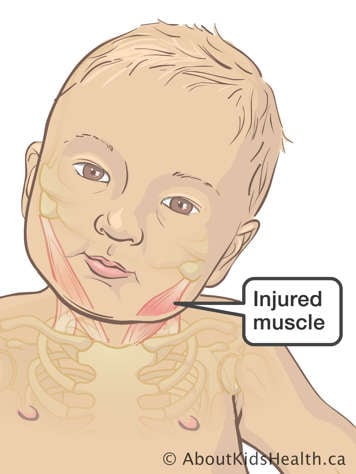What is torticollis?

Torticollis occurs when one of the neck muscles, called the sternocleidomastoid, is tighter on one side than the other. This causes your child’s head to tilt toward the side of the neck with the tight muscle and the head to turn to the opposite side.
What causes torticollis is unknown. It can often be treated with physiotherapy and stretching exercises in the first year of life. If your child continues to have significant limitations in movement after their first year of life, they may need surgery to treat the condition. The surgery is done when your child is old enough to be cooperative with physiotherapy after surgery.
The sternocleidomastoid muscle is responsible for turning the head to one side and for tilting it to the opposite side. Because this muscle is tight, you may have found that your child has an altered posture, difficulty looking one way and changes in their facial symmetry. For more information, see the article about Torticollis.
Who will I meet?
Torticollis is managed by a team of health-care professionals that includes a physiotherapist and a plastic surgeon.
The plastic surgeon will talk to you about the course of your child’s surgical treatment during your clinic visit. The surgeon will review with you the associated risks and benefits of the surgery.
The physiotherapist will see your child before surgery during the clinic visit and after surgery on the ward. Before your child’s surgery, the physiotherapist will fit them with a neck collar. After the surgery the physiotherapist will help you and your child with the exercises your child needs to do. They may also help you find an appropriate physiotherapist in the community when you go home.
What happens after surgery?
After your child’s surgery they may stay in the hospital for one night. After surgery, your child will be wearing a neck collar and may have some swelling on the side of the neck where the tight muscle was.
The physiotherapist will come the day after the surgery to begin doing exercises with your child. The physiotherapist will teach you and your child what to do at home. They will also make sure you are comfortable with all the exercises you need to do before you go home.
Your child may be in some pain after the surgery and the team will help you determine the best pain medication to make your child comfortable. It is important to make sure you reduce your child’s pain with medication, if necessary, so that the exercises can be completed successfully.
Will my child have any scars?
Your child will likely need an incision behind their ear and they may also require a small incision at their collar bone. With appropriate scar management, both of these incisions will heal well but will leave a visible scar. It will be important to keep both incisions clean as instructed by your health-care team. It will also be important to gently massage the scar twice a day with a lubricant and to keep the scar out of the sun once it is well-healed.
Will my child have to wear a neck collar?
Your child will be fitted with a neck collar prior to surgery by the physiotherapist. The collar is an important part of your child’s recovery as it will help to improve their posture and the range of motion of their neck. Your child will need to wear the collar during the day for the first four to six weeks and while sleeping for several months after the surgery. At the beginning, the collar will only be removed for exercises, bathing and occasionally for meals. The physiotherapist will work with you to create a wear schedule for the collar. They will also advise you about when it is OK to start removing the collar for longer periods of time.
What type of exercises will my child have to do?
The exercises after the surgery are a very important part of your child’s recovery. The exercises will begin the first day after your child’s surgery while they are in the hospital. Your physiotherapist will assist you with the exercises and make sure you are comfortable doing them with your child. You will need to do neck stretching and postural exercises with your child three to four times per day, every day. A physiotherapist will help you to progress to appropriate exercises throughout the recovery process. It will be important to continue with the exercises for up to one year after the surgery in order to have a full recovery. Exercises will be reviewed with you at your clinic visit and on the first day after surgery. The appropriate exercises will be prescribed to your child and these should only be done in consultation with your physiotherapist.